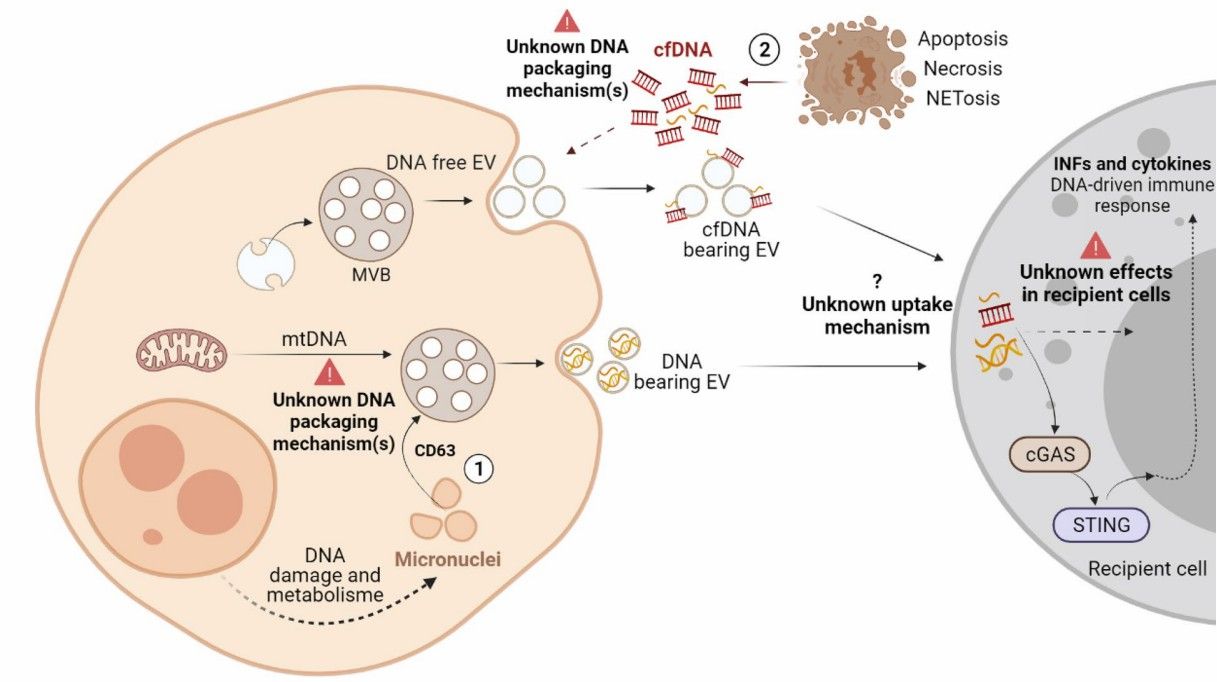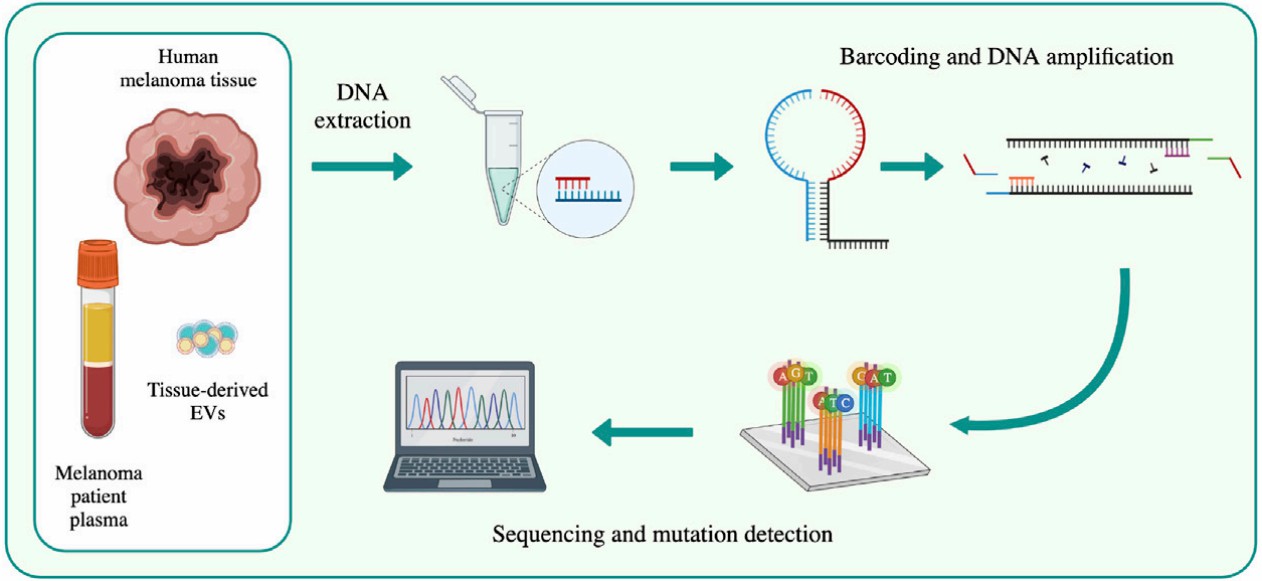Extracellular Vesicle DNA Isolation and Profiling Service
Overview Services Features FAQs
DNA isolation and profiling for EV (extracellular vesicle) provides researchers with access to high-throughput DNA sequencing and analysis of EV. Creative Biolabs provides DNA isolation and profiling services for EVs, supporting clients to study EV-mediated cellular communication and the genetic basis involved in related diseases.
EV DNA Description
EV DNA is found in EV as genetic material, typically consisting of short DNA fragments that are cell-free DNA (cfDNA). Cells release DNA fragments into the environment through necrosis, apoptosis, or active release, accompanied by the secretion of EV being encapsulated in them. The cfDNA from biological samples such as blood or saliva usually results in false positives in liquid biopsies due to the presence of nucleases that affect its fragment incompleteness. In contrast, the cfDNA of EV can provide the complete genetic composition, such as their cargo and origin, as a source of genetic information for research and clinical applications. This type of cfDNA serves for studying gene expression, investigating genetic changes associated with diseases or monitoring disease progression, as well as developing new therapeutic strategies and measuring treatment efficacy.
Creative Biolabs provides DNA isolation and profiling services for identifying the genetic and epigenetic components of EV, allowing for a better understanding of the role of these vesicles in cellular processes. Additionally, it is conducive to advancing the identification and discovery of biomarkers for EV DNA associated with specific diseases, enabling researchers to develop targeted therapies. Even more attractive, these services can be used to recognize and characterize novel EVs that may have therapeutic potential.
 Fig.1 The putative origin of EV-DNA.1, 3
Fig.1 The putative origin of EV-DNA.1, 3
EV DNA Isolation and Profiling Services in Creative Biolabs
Creative Biolabs performs EV DNA analysis using DNA-seq technology, which involves isolating EV from biological samples, extracting DNA from them, and then sequencing the DNA to determine the genetic elements present.
-
EVs are solubilized using detergents, chaotropic salts, or enzymes, and the DNA is separated from other components by centrifugation, filtration, or precipitation.
-
Further purification of the DNA is facilitated by ethanol precipitation, column chromatography, or dialysis techniques.
-
Quantitative determination of isolated DNA that meets the requirements will then be sequenced and compared by DNA-seq.
EV DNA-seq can be used to identify genetic biomarkers in EV, diagnose and monitor diseases, and study the role of EV in various biological processes.
 Fig.2 DNA sequencing was performed on human melanoma tissue, tissue-derived EVs, and melanoma patient plasma.2, 3
Fig.2 DNA sequencing was performed on human melanoma tissue, tissue-derived EVs, and melanoma patient plasma.2, 3
Features
-
High-Sensitivity DNA Isolation: Utilizing advanced techniques to isolate DNA from extracellular vesicles with high sensitivity, ensuring minimal sample loss and maximum yield.
-
Comprehensive Profiling: Detailed analysis of DNA content within extracellular vesicles, including quantification and sequencing, to uncover genetic insights relevant to research goals.
-
Quality Assurance: Stringent quality control measures to maintain the integrity and purity of isolated DNA, ensuring reliable and reproducible results.
-
Expert Support: Access to experienced scientists and technicians who guide throughout the process, from sample preparation to data interpretation.
EVs are shed from cells with variable composition and mediated functions of protected DNA within their lipid bilayers that can be reflective of the health and disease status of parental cells. Creative Biolabs provides DNA isolation and profiling services for EV that support the study and characterization of a more stable and representative source of genetic information as a potential biomarker. Please contact us to advance your research.
FAQs
Q: How are DNA extractions from extracellular vesicles performed?
A: We employ specialized methods such as ultracentrifugation or precipitation-based techniques to isolate DNA from EVs. These methods are optimized to minimize contamination and ensure high purity.
Q: What types of genetic analyses are offered for EV DNA?
A: Our services include qPCR, NGS, and digital droplet PCR (ddPCR), enabling detailed profiling of EV DNA for various research applications.
Q: Can you customize protocols to fit specific research needs?
A: Yes, we offer customized protocols tailored to your research objectives, ensuring that the extracted DNA meets the requirements for downstream analyses or clinical applications.
Q: How do you ensure the quality of isolated DNA?
A: We implement rigorous quality control measures throughout the isolation process to maintain DNA integrity and purity, supported by validation through multiple analytical techniques.
References
-
Ghanam, Jamal, et al. "DNA in extracellular vesicles: From evolution to its current application in health and disease." Cell & Bioscience 12.1 (2022): 37.
-
Crescitelli, Rossella, et al. "Extracellular vesicle DNA from human melanoma tissues contains cancer-specific mutations." Frontiers in Cell and Developmental Biology 10 (2022): 1028854.
-
Under Open Access license CC BY 4.0. The image was modified by revising the title.
For Research Use Only. Cannot be used by patients.
Related Services:

 Fig.1 The putative origin of EV-DNA.1, 3
Fig.1 The putative origin of EV-DNA.1, 3
 Fig.2 DNA sequencing was performed on human melanoma tissue, tissue-derived EVs, and melanoma patient plasma.2, 3
Fig.2 DNA sequencing was performed on human melanoma tissue, tissue-derived EVs, and melanoma patient plasma.2, 3









